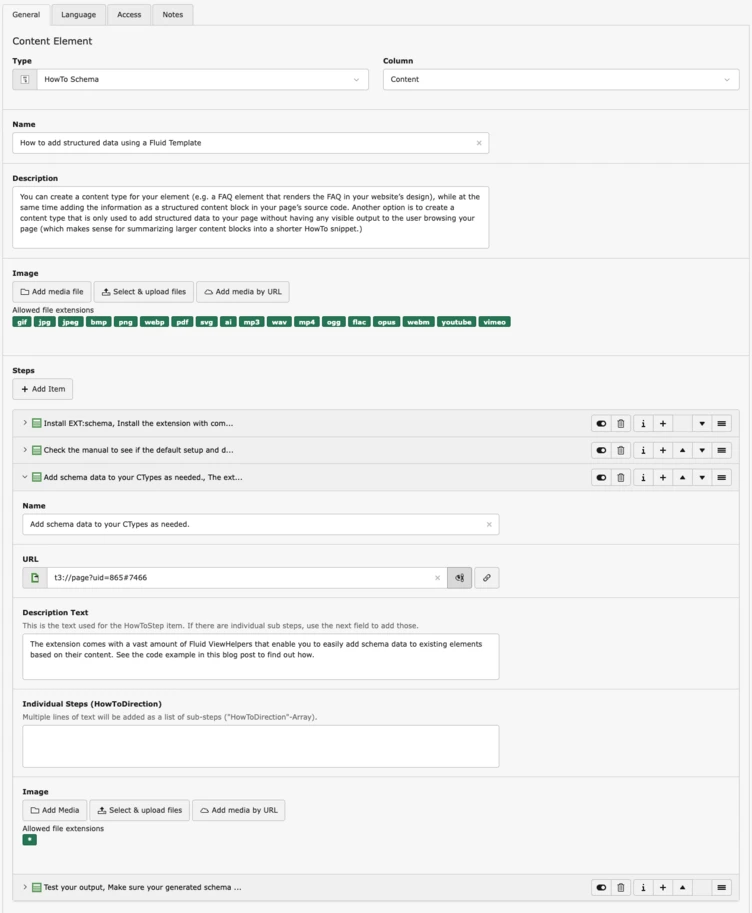Maximizing Website SEO with Structured Data in Google’s Search Generative Experience

Google’s Search Generative Experience (SGE) expands the experience of searching the web using generative AI. When you search for something on Google, it provides concise overviews of key terms and interactive follow-up questions.
SGE naturally raises questions for businesses who want to be found on the Google results page. Digital marketers and Search Engine Optimization (SEO) specialists need to understand how to design web content to align with AI-driven search results and, from there, how Google’s SGE impacts SEO strategies. Web developers, meanwhile, must implement structured data for better search visibility. Content creators’ and strategists’ goal is to produce content optimized for Google’s evolving search algorithms while simultaneously tailoring content planning to the requirements of AI-driven search engines.
The good news is that by keeping a few SEO best practices in mind, you can help SGE give your website a prominent place in any related search results it returns.
In this article, we’ll take a look at how SGE works in more detail, with a particular focus on the importance of structured content for search visibility. We’ll also discuss how the TYPO3 CMS is perfect for implementing good structured content practices and share some tips from b13 to help you equip your website with the SEO-friendly content you need!
Contact b13 to take advantage of our expertise in TYPO3, UX, and optimizing sites for SGE.
What is Google’s Search Generative Experience (SGE)?
Google’s Search Generative Experience (SGE) is a tool that expands search engine possibilities — and refines what searches can do on a granular level — using generative AI.
Its two main services are search overviews and follow-ups. When you search for a topic, Google will first supply you with a succinct summary of the fundamentals of the person, place, thing, or idea you’re looking to learn more about. From there, it will provide examples of frequently asked follow-up questions, as well as space for you to ask your own. This technology aims for a conversational approach that gets all the information you need. The more questions you ask, the more detailed the summarizing information becomes.
Google recognizes that a one-size-fits-all approach doesn’t apply to questions and search topics, and it consequently organizes its responses into four main categories:
- Getting acquainted with new subject matter:
A search for a topic concerned with nature, history, or another field of knowledge will generate an easily digestible survey of the topic’s main components, as well as entry points for deeper exploration. - Instructions, directions, and tips:
A search for how to perform a task or troubleshoot a problem will yield a kind of condensed manual: bulleted lists of instructions supplemented by helpful tips for achieving the desired result. - Fielding and synthesizing opinions:
A search for something that generates a lot of discussion or reviews (the example Google gives is a public monument) creates a panorama of other users’ opinions from which the searcher can draw conclusions and make decisions. - Product and price comparisons:
A search that Google recognizes to be shopping-related will deliver an array of similar products, allowing the searcher to compare and contrast prices and get the best quality for the best deal.
With this variety of responses, Google aims to deliver a jumping-off point for any search on any topic. For businesses, this provides a powerful incentive to adapt content for SGE so as to be featured in these AI-driven responses. This involves careful attention to SEO — in particular, to structured content.
The importance of structured content in the AI-driven search era
SGE is able to work because of structured content, which enables its algorithms to detect information relevant to a searcher’s query.
Structured content itself is part of a broader concept known as the Semantic Web. This refers to enhancing the World Wide Web by enabling data to be shared and reused across application, enterprise, and community boundaries, effectively by turning it into a database that can be queried more easily. In the Semantic Web, data is given well-defined meaning by structuring it so it can be used by machines not just for display purposes, but also for automation, integration, and reuse across various applications. Its ultimate goal is to create a universal framework that enables data interoperability across the entire web.
Structured content in particular focuses on the format and organization of data within individual webpages or documents. It involves designing content in a way that is systematically organized and tagged with metadata. Let’s take the example of a well-structured recipe webpage, which could be structured using the following tags:
- Headings and subheadings (e.g.,
<h1>,<h2>):
The recipe title is marked with an<h1>tag, indicating its primary importance. Subsequent sections like “Ingredients,” “Instructions,” and “Cooking Times” use<h2>tags, distinguishing these as major subsections. This hierarchical use of heading tags structures the content in a way that is easy for both users and search engines to navigate. - Paragraphs (e.g.,
<p>):
Descriptive text, such as the recipe’s introduction or specific notes about preparation, is enclosed in<p>tags. These paragraph tags break the text into manageable, readable blocks. - Lists (e.g.,
<ul>,<li>):
Ingredients and step-by-step instructions are often presented in list format. An unordered list (<ul>) or ordered list (<ol>) with list items (<li>) is used for these sections, making them easily scannable for users and structurally clear for search engines. - Schema.org markup (e.g., itemprop, itemscope, itemtype):
This is where the structured content becomes semantically rich. Attributes from schema.org vocabulary are added to the HTML tags. For instance, the ingredient list might includeitemprop="recipeIngredient"within each<li>tag, clearly indicating to search engines that these list items are ingredients of the recipe. Similarly, cooking time might be marked withitemprop="cookTime", and so on. This level of detail in metadata helps search engines understand the content of each section, enabling features like rich snippets in search results. - Semantic HTML5 Tags (e.g.,
<article>,<section>):
Semantic tags provide additional context. An<article>tag could wrap the entire recipe, signifying it as a self-contained composition. Individual sections like ingredients and instructions might be enclosed in<section>tags, further organizing the content semantically.
By combining these HTML tags and schema.org annotations, the webpage not only becomes easier to read and navigate for users but also becomes a rich resource for search engines.
AI-driven search engines like SGE rely heavily on structured content. Such search technologies use algorithms that can understand and interpret the structure of web content. When content is well-structured and tagged with appropriate metadata, these algorithms can more effectively parse, index, and retrieve information, leading to more accurate and relevant search results.
Challenges and opportunities: Adapting websites to SGE
Taking steps to make your website compatible with SGE is the best way to ensure sustained relevance and gain the most accurate insights into who is searching for your goods and services.
Firstly, before we talk about structured content, you should consider how your content itself relates to SGE. Every piece of content tells a story. SGE is tapping into this approach by enabling searchers to participate in the “story” of their own education on a given subject. Think about how an average user might begin to learn about your product or service, what questions they might ask from there, and what other information might be useful to them. Allow this natural progression to guide your content creation — a bit like carrying out Search Engine Results Page (SERP) analysis, considering the queries and intent that lead users to web pages.
Once you’ve planned your content, you then also need to pay attention to structured content principles when building your pages:
- Incorporate rich snippets:
Apply schema.org markup to provide detailed information about your webpage’s content. This enhances how search engines comprehend and showcase your content in search results. For example, if you’re running a recipe website like the one discussed above, use schema markup to highlight ingredients, cooking time, and nutrition facts. This could lead to your recipes being displayed as rich snippets in search results, featuring key information at a glance. - Ensure consistent data structuring:
Maintain a uniform structure for your website’s data. This consistency aids AI algorithms in more effectively parsing and categorizing the content. For instance, if you have a product catalog, use a consistent format for all product descriptions, prices, and specifications. This uniformity helps search engines index your products more accurately, improving their visibility in relevant searches. - Utilize clear metadata:
Embed clear and relevant metadata for each content piece. This approach effectively communicates the context and purpose of your content to search algorithms. An example could be adding descriptive alt text to images on your site, which helps search engines understand and index these images properly, enhancing the accessibility and searchability of your site. - Focus on accessibility and readability:
Design your content to be both accessible and easy to read. This strategy benefits not only your users but also assists AI-driven search tools in accurately interpreting and ranking your content. For instance, ensure your website text has sufficient contrast against its background, use legible fonts, and structure your content with headings and subheadings. Improved readability and accessibility can lead to better user engagement and higher search rankings. - Leverage linked data principles:
Adopt linked data principles to create a more interconnected and semantically rich web environment. This practice enhances the functionality of AI-driven search technologies. For example, use RDF (Resource Description Framework) to link data items from your website to other related data across the web. This linkage can provide context to your content, making it more understandable and valuable to both search engines and users, potentially increasing the reach and relevance of your site in search results.
Of course, using structured content doesn’t mean you can forget about more general SEO principles! Remember to pay attention to the following:
- Strike a balance between education and accessibility:
Make sure you know your audience when creating your content. If it consists mostly of experts in your industry, take care that your texts hit all the right points to draw them in. If it’s more an audience of laypeople you’re catering to, keep your language simple and punchy. Whomever you’re addressing, write in a way that will inspire them to want to learn more. - Include relevant keywords — but not too many:
Keywords are the bread and butter of effective SEO, but there’s a limit. Steer clear of “keyword stuffing” for the sake of using jargon: your audience will be able to tell, and it will detract from the tone of your content. Maximizing the impact of your headings and subheadings will take you far. - Design your pages with images and video:
Overloading your site with text can be taxing on a visitor. Break it up with engaging visuals, graphs, and videos where appropriate. The most relevant of these can also show up in an SGE search result. - Flesh out your content with backlinks:
Including sources of further information for your site’s visitors will increase your standing in a search engine tool dedicated to providing further reading. Enrich your content with links to other pages of yours and reputable external sources. The more research your content pulls from, the more likely it will be to appear in a curated SGE list.
This is a lot to pay attention to. But thankfully, there are tools that can help you follow the best structured content principles — starting with your content management system (CMS).
Leveraging TYPO3 for enhanced search performance
The TYPO3 CMS is a great choice if you want to ensure your content appears in as many search results as possible. It supports a number of features that can enhance your general SEO work, both generally, and in terms of structured content:
- SEO extension in TYPO3 Core:
TYPO3 includes an SEO Core extension, which allows users to set metadata at a page level, like unique titles and descriptions based on what website visitors are searching for. It also includes settings for web crawlers, such as enabling indexing and following of a page, and managing canonical links for pages with duplicate or similar content. - Custom URL management:
With TYPO3, users can create and update readable URLs, which is crucial for SEO. When a page’s title is updated, TYPO3 automatically updates the URL slug and can create redirects, including those of subpages. This feature ensures URL consistency, which is beneficial for both user navigation and search engine indexing. - Rich snippets and structured data:
TYPO3 supports the integration of rich snippets and structured data using schema.org markup. This functionality is vital for enhancing how pages are displayed in search results, making them more informative and attractive to potential visitors. - Multilingual and multisite support:
TYPO3 is designed to handle multiple languages and sites efficiently, which is essential for global SEO strategies. The CMS automatically creates URLs for different language versions of the same page, reducing the risk of errors and improving content reach across various regions and languages. - Mobile-first approach:
TYPO3 let's you build responsive design, ensuring content is optimized for various devices. This approach aligns with Google’s mobile-first indexing, where the mobile version of content is primarily used for indexing and ranking. - XML sitemaps:
TYPO3 generates correct and updated XML Sitemaps, which are crucial for SEO. These sitemaps help search engines understand the site structure and index web pages more effectively.
What’s more, TYPO3’s advanced functionality for content types is perfect for making it easy to work with structured content in a reliable, repeatable manner. The flexible options for easily defining your own content element types (CTypes) lower the hurdle for creating content elements and allow editors to insert blocks optimized for SGE.
Let’s have a hands-on look at how to work with these structured content features in TYPO3.
Practical insights: How to implement structured content in TYPO3
At b13, we implement structured content in TYPO3 using the TYPO3 extension “schema.” This extension can add certain types of structured content to your pages (like a breadcrumb snippet), but we use it to create custom content types to enable editors to add structured content to their pages.
EXT:schema comes with PHP classes that you can use in your code to add schema data to your pages, and allows TYPO3 integrators to create schema markup in their Fluid Templates. This enables you to add structured data markup based on editor’s input, and add structured content to existing content types. For example, you can create a content type for your FAQ element that renders the FAQ in your website’s design, while at the same time adding the information as a structured content block in your page’s source code. Another option is to create a content type that is only used to add structured data to your page (which makes sense for summarizing larger content blocks into a shorter HowTo snippet).
- Install EXT:schema
Install the extension with composer:composer req brotkrueml/schema - Check the manual to see if the default setup and default configuration meet your needs.
The extension will add certain defaults to pages depending on the type of page an editor selects. Adjust these settings (or remove them if you want to use custom configuration) accordingly. - Add schema data to your CTypes as needed
The extension comes with a vast amount of Fluid ViewHelpers that enable you to easily add schema data to existing elements based on their content. - Test your output
Make sure your generated schema data is fully valid. You can use testing tools like validator.schema.org to validate your source code.

Example for a simple HowTo snippets in Fluid:
1
2
3
4
5
6
7
8
9
10
11
12
13
14
15
16
17
18
19
20
21
22
23
24
25
26
27
28
29
30
31
32
33
34
35
36
37
<schema:type.howTo
name="{data.header}"
description="{data.bodytext -> f:format.htmlentities()}"
>
<f:if condition="{files.0.uid}">
<schema:type.imageObject
-as="image"
url="{f:uri.image(src: files.0.uid, treatIdAsReference: 1,
absolute: 1, width: ‘1600c’, height: ‘900c’)}"
width="1600"
height="900"
/>
</f:if>
<!-- {listitems} is an array of sub elements, see EXT:listelements -->
<f:if condition="{listitems}">
<f:for each="{listitems}" as="item">
<schema:type.howToStep
-as="step"
url="{f:uri.typolink(parameter: item.data.link, absolute: 1)}"
name="{item.data.header}"
text="{item.data.bodytext}"
>
<f:if condition="{item.listassets.0.uid}">
<schema:type.imageObject
-as="image"
url="{f:uri.image(src: item.listassets.0.uid, treatIdAsReference: 1,
absolute: 1, width: ‘1600c’, height: ‘900c’)}"
width="1600"
height="900"
/>
</f:if>
</schema:type.howToStep>
</f:for>
</f:if>
</schema:type.howTo>
Preparing for the future of search
Getting your website ready to meet the demands of SGE and other increasingly sophisticated AI-powered search tools is a tall order, from crafting the highest-quality SEO content to designing attractive and accessible landing pages. b13’s expert TYPO3 and UX services can expedite your journey to maximum visibility in search results.
We can help you align your brand and web design, keyword- and SGE-optimize your content, scale the growth of your business, test ideas using wireframing and prototyping, find the right information management system for you — and much more.
The future of search has already started.
Get in touch with b13 to learn more about how we can make sure your site is ready.
